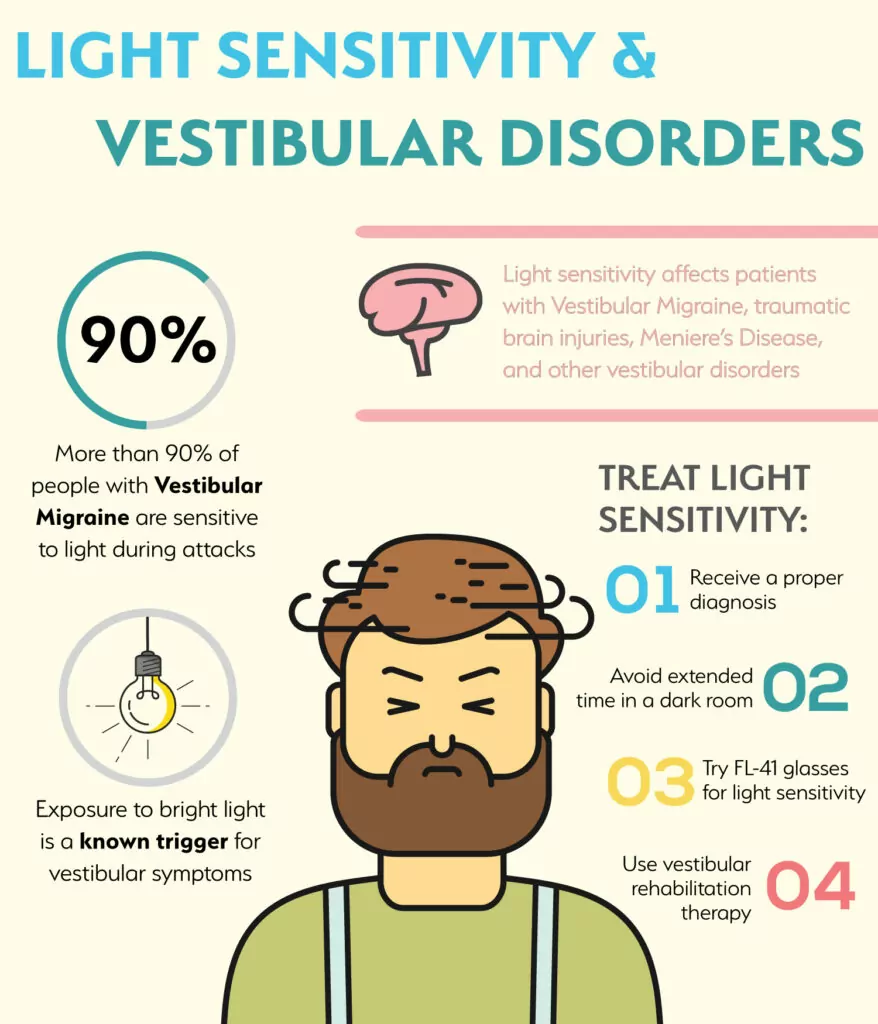The effects of chronic light sensitivity, also known as photophobia, are profound for those who experience it on a daily basis. It can cause pain in the eyes and brain, trigger physical symptoms of an underlying condition and even produce feelings of anxiety and isolation—and sometimes it only takes just a few seconds or minutes of exposure.
The connection between light sensitivity and certain vestibular disorders is no different. A significant number of patients with these conditions must also endure the challenges of being light sensitive. And in their case, light acts as a catalyst for dizziness, vertigo, lightheadedness, headache and other symptoms that are often associated with these disorders. In this article, we take an in-depth look at the experiences of those with vestibular-related photophobia and offer tips for keeping it in check.

Types of Vestibular Disorders Affected by light-sensitivity
Vestibular Migraine
It should come as no surprise that vestibular migraine carries perhaps the highest risk of light sensitivity symptoms. Migraine and headache disorders have long been associated with external sensitivities to light,
noise and/or smell; and in fact, sensitivity to light is often cited as the second most common symptom during attacks after only head pain. In addition, photophobia is included as a key diagnostic indicator for migraine with and without aura, according to the International Classification of Headache Disorders (3rd Edition).
Patients with vestibular migraine (also known as migraine-associated vertigo) are similarly affected by photophobia. More than 90% have reported negative or painful reactions to light during their vestibular episodes, ahead of other issues like nausea and headache. Even between attacks, people with vestibular migraine can have a heightened sensitivity to their environment and feel discomfort under bright lighting.1
Similarly, we cannot discount the role of light exposure in the onset of vestibular migraine attacks. Bright and/or flashing lights are frequent triggers for more than one-quarter of patients with the condition.1
Light sources that may cause the most problems include:
- Fluorescent lighting
- Digital screens (computer, smartphone)
- Bright sunlight and outdoor glare
As a result, exposure to this and other forms of bright light can lead to hallmark vestibular symptoms (e.g. dizziness and lightheadedness) as well as typical migrainous features (e.g. head pain, visual aura and nausea).
Traumatic Brain Injuries and Post-Concussion Syndrome
Traumatic brain injuries (TBI), regardless of severity, are one of the leading causes of vestibular complications, and they also can negatively impact a patient’s tolerance for light as well. Not only are dizziness and light sensitivity regular symptoms within the first few days after a concussion (>40%), but their presence during this time may predict the likelihood of long-term symptoms a year or more later.2 Sadly, they can also become a chronic problem for many, persisting for years after the initial trauma.
Only recently have researchers begun to explore how light sensitivity and other visual inputs can lead to the vestibular effects associated with brain injuries. One study found that more than half of teenage athletes who endured a sports concussion cited computer use and television watching as triggers of their dizziness.3 While motion sensitivity may also be a compounding factor, it is likely that the artificial light exposure also contributed to these experiences. And this is reinforced by repeated findings that people with concussion have a lower threshold for bright light.4,5 Much like migraine, this makes patients susceptible to having their post-concussion and post-TBI symptoms induced by light—even at levels that others may not consider bright at all!
Meniere’s Disease
Another leading cause of dizziness and vertigo is Meniere’s Disease, which is caused by a chronic buildup of fluid in the inner ear. You might be wondering then: How does an inner ear disorder translate to symptoms of light sensitivity? The answer likely lies in the connection between Meniere’s Disease and migraine.
Research has shown that people with Meniere’s Disease are twice as likely to also have migraine. Even in the absence of a formal diagnosis of headache disorder, nearly half of Meniere’s patients have at least one migrainous symptom as part of their vestibular attacks—including sensitivity to light. Even though people with migraine and vestibular migraine are far more likely to experience regular photophobia, evidence suggests that at least 40% of those with Meniere’s are still subject to these sensitivities.
Similar to other vestibular conditions, Meniere’s patients can also be triggered by visual environments that feature intense lighting and/or disorienting movement. Some examples include:
- Bright, flashing or flickering lights
- Supermarket or shop environments (with fluorescent lighting)
- Watching television or using the computer
Severe vertigo and unsteadiness are just two of the symptoms that they can experience as a result of being exposed to these types of environments.7
While visual triggers may not be as prominent as other factors (such as stress or posture), they still cannot be discounted as significant concerns for those with Meniere’s Disease.
Other Vestibular Disorders
Other forms of vestibular dysfunction may also feel the negative impact of light and visual stimuli. Visual vertigo is a known side effect for many vestibular disorders, and it can be brought on by complex, distorted and/or moving imagery. Although not directly linked to light sensitivity, experts believe that harsh or high-contrast lighting (such as flashing emergency lights) can activate the central nervous system and ultimately compound the disorientation that patients may feel in these environments.8
In addition, dizziness and related vestibular symptoms have been shown to increase with age, regardless of cause. And light sensitivity has been anecdotally connected to the onset of dizziness and vertigo in older populations. In fact, here is how one patient described the feeling:
“Also the light, irritating the eyes. I don’t look into the shop-window, instead I walk through dark or quiet streets…”9
No matter your age or vestibular condition, the unpleasantness of photophobia is often a debilitating complication.
How to Treat Vestibular-Related Light Sensitivity
Proper diagnosis. The first step of any treatment plan begins with appropriate diagnosis. Patients and their physicians need to know exactly what is causing the dizziness symptoms. This approach can thus lead to individualized therapies for specific symptoms while also addressing the primary disorder with time-tested treatment options.
Avoid dark adaptation. The instinct for many patients who suffer from light sensitivity may be to avoid light exposure by hiding in a dark space or wearing sunglasses inside. However, this can worsen a person’s photophobia over time as their eyes adapt to the darkness. Recent CDC guidelines further reinforced patients to steer clear of “cocoon therapy” (staying in a dark room with no stimulation) and gradually re-introduce regular activities, particularly after a concussion.
FL-41 glasses. Dating back to early-1990’s clinical research, a specialty tint known as FL-41 has provided therapeutic benefit to those with photophobia. The tint has been shown to decrease light-induced migraine attacks by 74% and help alleviate fluorescent- and artificial-light sensitivity. It has also been effective with thousands of patients with vestibular migraine, post-concussion syndrome and other vestibular disorders. The reason it is so effective has to do with its filtering of specific wavelengths of blue-green light—wavelengths which are known to activate sensitive brains and bring about symptoms of chronic vestibular and neurological conditions.10,11
Vestibular rehabilitation. Another evidence-based treatment method is vestibular rehabilitation. This process utilizes simple exercises to improve vestibular symptoms like balance issues, visual complications and motion-induced dizziness. In addition, neurologic physical therapists (Neuro PTs for short) have specialization in neurological disorders like migraine and concussion, giving them additional insight into the unique complaints of patients. They can help retrain the brain through a combination of rehabilitation exercises, assistive technologies and other innovations in treatment.
Infographic designed by Gregory Bullock, Marketing Director for TheraSpecs.

 NO MORE GLARE
NO MORE GLARE